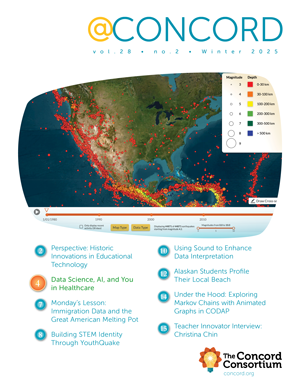Three Decades of Educational Innovations
The Concord Consortium began with a handful of enthusiastic employees working out of an old house on Thoreau Street in Concord, Massachusetts, under a sign that announced our work as “an educational technology lab.” We were led by the brilliant physicist Robert Tinker and the idea, revolutionary at the time, that technology could make a difference in education. Bob believed wholeheartedly in the power of curiosity to bring out the inner scientist in everyone. Our first grant from the National Science Foundation, called “Hands-On Physics,” introduced themes that have been consistent throughlines over the three decades since our inception: student inquiry inspired by innovative educational technology and equitable access to digital resources.
Using inexpensive materials—the Hands-On Physics team made frequent trips to Radio Shack to buy all manner of electronics equipment from wire cutters to soldering guns—the project empowered students to gather their own data as real scientists do. No longer was physics merely abstract words in a textbook. Students were able to make independent discoveries about physical laws, investigating concepts such as thermal radiation, phase change, and other previously perplexing subjects. The development of powerful but economical technology, including the first educational probeware, was a game changer for science classrooms, especially those in underfunded rural and urban schools. Using probes connected directly to a live graph display of the data they produced, students explored their own ideas as experimental data collection became quick, easy, and accessible.
With innovation and access top of mind, the Concord Consortium anticipated online education’s ability to cross geographic and economic boundaries as it developed the first virtual high school cooperative.“Brick and mortar” schools across the country could suddenly offer a wide range of high-quality courses previously unavailable locally: Advanced Placement, biochemistry, music, geometry, and much more. The Virtual High School project eventually spun off as an independent school (now VHS Learning) that offers over 260 different courses to public and private institutions, as well as homeschoolers. Paramount to the viability of this innovation was the development of interactive online courses, far more effective than simply video talking heads. To spur course development, the Concord Consortium developed a much-needed e-learning model, which would serve as a roadmap for anyone who wanted to develop online courses for students or teachers. These first “netcourses” and the inquiry-based model for online teacher professional development they introduced increased access to training and professional practices worldwide.
Making the invisible visible and explorable
Continuing our mission to engage students in science beyond the traditional lab, we developed the groundbreaking Molecular Workbench in 1999. Using sophisticated computational methods based on first principles (e.g., solving Newton’s equation of motion for interacting particles), the Molecular Workbench simulates atomic scale phenomena and permits students to interact with them.
Students from grade five through college could now experiment with atomic-scale systems to learn through exploring accurate simulations. The Molecular Workbench has since been used for topics in physics, chemistry, biology, and engineering, including gas laws, fluid mechanics, states of matter, chemical reactions, the genetic code, protein synthesis, electron-matter interactions, and quantum phenomena. But the real superpower of these simulations lies in their interactivity: students can manipulate variables as scientists do. With funding from Google.org in 2011, we made another innovative leap by reprogramming the models in HTML5 so they would run directly in modern web browsers.

By making Molecular Workbench simulations interactive, our goal was to help students develop a solid conceptual understanding that is difficult to achieve using traditional curriculum materials. Over the years, we have continued to develop numerous interactive computational models based on scientific laws. We have diversified our portfolio of educational simulations for studying genetics, evolution, earthquakes and volcanic eruptions, global warming, biological phenomena, and other science topics. These simulations empower students to do the previously unimaginable: manipulate the Earth’s tectonic plates, modify genetic alleles, explore the relationship of various ecosystem components, and much more.
Hands-on learning is our byword for learning by doing. Technology not only offers the potential for engaging students in specific science topics but also forms a backdrop for learning about big picture concepts. These concepts, such as system modeling or computational thinking, play vital roles in our increasingly inter-connected, technology-driven world. By moving learning past memorizing facts in a textbook or watching simplistic YouTube videos, technology can engage learners in generating and analyzing real data about topics they care about. In such cases, students take ownership of their learning, adopting new perspectives on the processes of science and how problems are solved.

Looking to the future
We are also keeping our eye on AI. Students will need to know what it is and how it can be used. One new initiative is developing a year-long Artificial Intelligence in Math supplemental certificate program for secondary Algebra I or Integrated Math I classes. And, in a merging of our past with this new future, two public virtual schools will implement the program. In other projects, we are showing teachers how they can train and use AI to gather relevant information about their students’ progress and better understand how to help them learn. (Read about our work in AI.)
Throughout all Concord Consortium projects, our aim is to make our work available to all by providing open-source software and openly licensed curriculum resources. Our STEM Resource Finder houses free activities and interactive computational models where teachers can easily create classes, assign activities, and track student progress. This is just another way the Concord Consortium continues to follow the values inspired by our founder Bob Tinker to expand educational opportunities to everyone, everywhere.
*Amazon was launched in July 1994, a month before the Concord Consortium’s bylaws were signed. At the time, Amazon existed as a bookstore only, not the megastore it is now.
Note: The images for this article were created with ChatGPT.
Cynthia McIntyre (cmcintyre@concord.org) is the director of communications.
Lee McDavid was the director of communications from 1997 to 2001.
This material is based upon work supported by Devin Finzer, the Valhalla Foundation, the University of Chicago Center for RISC, the U.S. Department of Education (S411C230070), and the National Science Foundation under Grant No. DRL-2325871. Any opinions, findings, and conclusions or recommendations expressed in this material are those of the author(s) and do not necessarily reflect the views of the funders.

